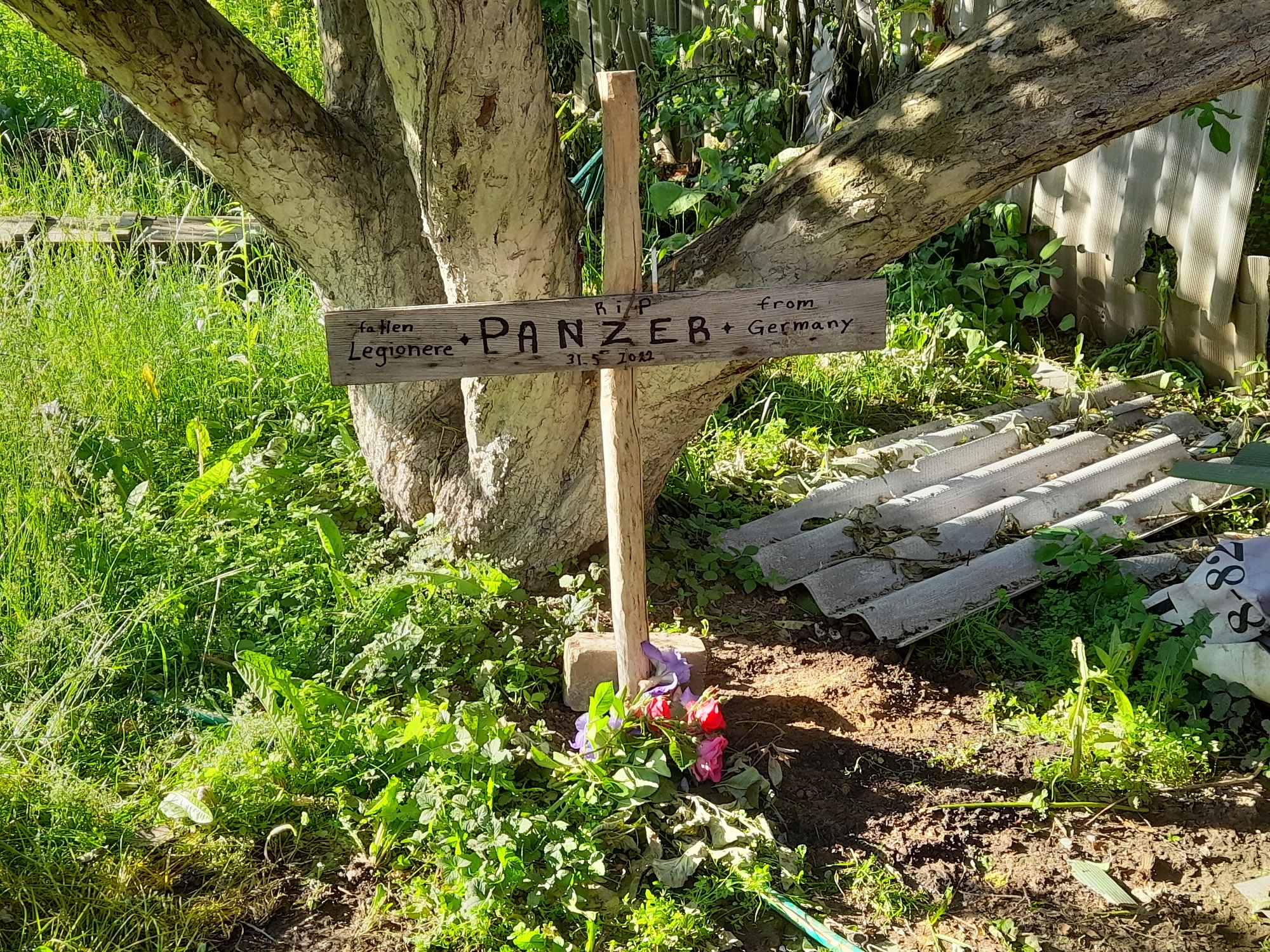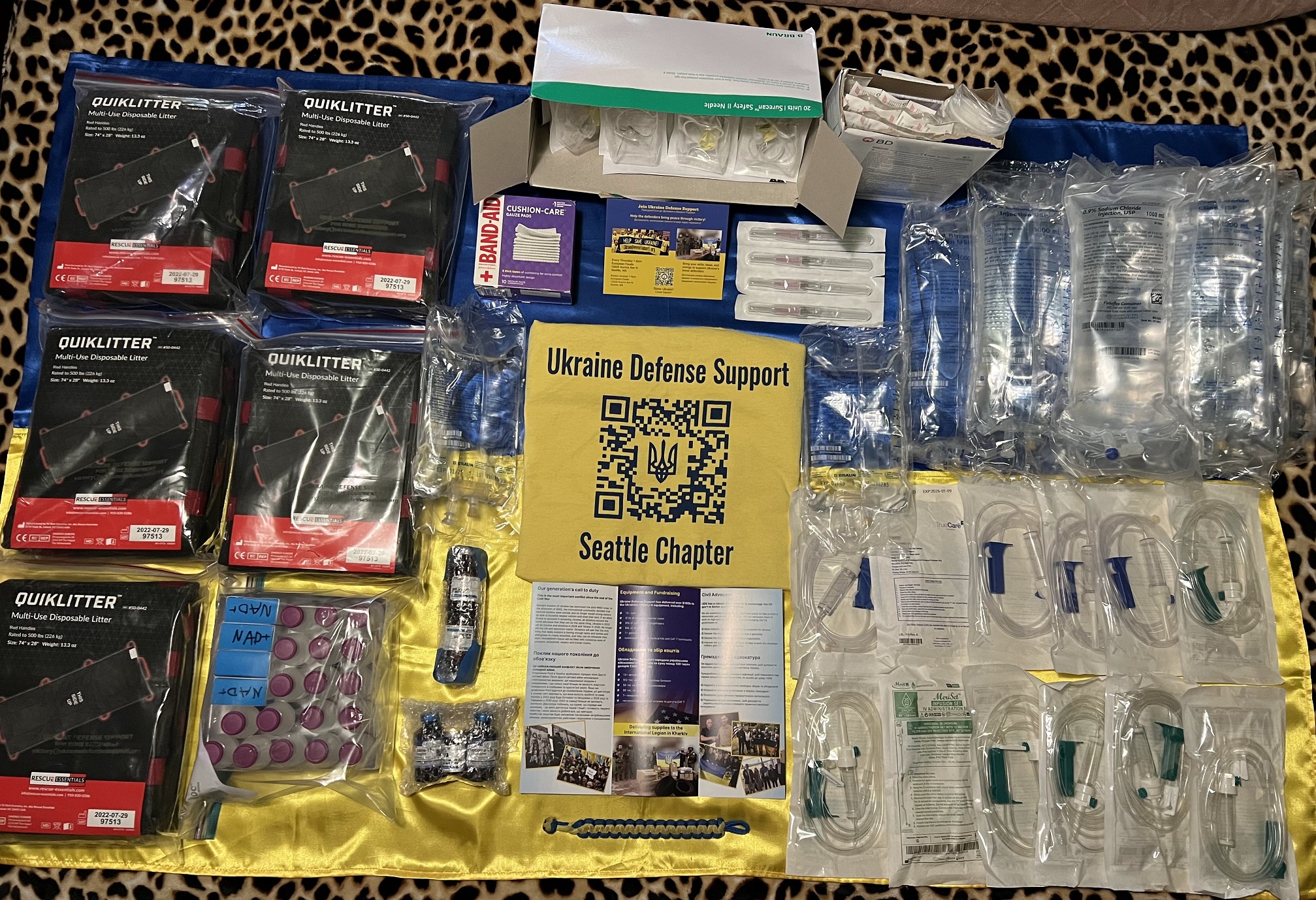
In June 2022, I found myself perched precariously on the second-story roof of an abandoned house in the far east of Ukraine, listening to Russian mortar rounds impact closer and closer. As I risked a broken neck or worse trying to get mobile service, I caught myself laughing at the surreal, impossible nature of where I was. I could be back in Seattle with my beautiful wife, working at my comfortable IT job, building my even more comfortable future. Instead, here I was, 10 meters up in the air in far northeastern Ukraine, leaning over the slippery corrugated galvanized roof, holding my phone in front of the jerry-rigged signal booster I had fashioned out of a satellite dish antenna, all so I could max out my last credit card to buy a desperately needed generator for my brothers in arms, so no more of them would die.
Just two days earlier, we lost Panzer and it weighed heavily on our entire unit. Bjorn “Panzer” Clavis had been a much beloved German soldier who had suffered his share of hardships in our unit but was always dependable, always reliable. His English had gone from nonexistent to just heavily accented in less than three weeks. Now he was a frozen corpse somewhere in a Kharkiv morgue.
The mortars got closer.
WHAM!
WHAM!
I wondered which neighbors’ yards they were hitting, and if the civilian stay-behinds in the village had enough warning before getting hit. The town of Molodova, an hour east of Kharkiv, was in better times a vacation village, evidenced by the expensive fishing rods and bicycles we found in the houses we had requisitioned for military use. But better days were long gone for this battered little hamlet. The Russians had occupied the town in the early stages of the war. Now, although we’d pushed them back across the wide SeveroDonetsk river, they still waged brutal war against Ukrainian and International Legion troops they knew were guarding the other bank. They mortared, shelled, sniped, and droned us constantly.
Woooooooooooeeeeeeeeeeeeeeee Wham!
Okay, too close that time. Anytime you can hear the whistle, it’s too close. I left my phone in front of the dish, then scrambled back in the second-story window and hustled down the stairs to crouch in the reassuring protection of the stout concrete walls. I was alone in there. The rest of my unit had made a tactical withdrawal 100 metres away to the safety of a house with a much better bunker. My sole job was to connect to our tenuous supply lines in Kyiv and Kharkiv, as I was the only soldier in the platoon with a working cell phone.
Suddenly I heard the voice from upstairs. “JDI DO PREDELE!” The slavic curses didn’t sound like Ukrainian. More like guttural Russian. I’d left my rifle upstairs, propped against the wall. Great. I crept up the stairs, and took out my tiny knife. I might kill some Russians with amusement once they took a look at it. Why had I removed my yellow arm tapes the day before?! Oh yeah, they fell off, completely grimed with dirt. If I ended up shot by a “friendly” Uke for lack of colored tapes, I hoped my brothers would make up a more heroic story.
“Greench? Are you tere, broda?” English! Heavily-accented but still recognizable. I flew up the staircase to learn that my phone had finally connected. On the other end in Kyiv was Legion logistics mastermind “Santa.”
Santa had been swearing in his native Czech, which I mistook for Russian. I leapt out onto the hot roof, oblivious to when and where the last shells fell and grabbed the phone. “I’m here, brother! Great to hear you!” I had known Santa for months, since even before I had joined the Legion in April, when I worked as a civilian volunteer to the Ukrainian Legion recruiters. We kept bumping into each other at different parts of my circuitous, surreal journey from civilian volunteer to Legion trainee, Platoon Commander, Rifleman, head of Combat Support, and on through many other roles serving the Ukrainian military.
Santa’s built-from-scratch logistics operation was key to my overriding goal of keeping the men in my platoon alive. “Is everything OK, broda?” I looked around the cratered backyard of the house. OK?? Depends on the definition. In the distance I could see smoke from another house on fire. My gaze lingered on the still shiny red of Panzer’s blood on the garden tiles below. That was definitely not OK. We needed gear. I listened through the sudden quiet for more impacts. “Yes, everything’s good. No problems. Just checking in about that Turkish generator. I’ve got the credit card handy.”
After I signed off with Santa, I pondered the reality of this war: Why on earth did we not have a damn generator? For three days I lived in that ruined, once impressive country home, cajoling the mobile phone signal spirits and all the logistics powers that be to get us more equipment. Like a generator to power our electronics. Like an anti-drone gun, to free us from the buzzing tormentors that drove us inside several times a day. Like a vehicle, for God’s sake, so that we could evacuate an injured comrade, unlike poor Panzer, who had bled out over an excruciating 40 minutes while we had to send a runner to beg for a vehicle.
 The true answer to why we did not have enough critical equipment was part the inevitable shortfalls that occur when a developing country balloons its army from 200,000 to over a million in the course of a single month to fend off invasion by a ruthless enemy many orders of magnitude bigger. On February 24, 2022, when Russians launched their full-scale invasion of Ukraine, ordinary Ukrainians–men, women and children–stood up to the invaders with whatever they could find or make, to defend their homes and cities. There was no question they would fight, equipped or not. They were fighting for their sovereignty, for their freedom, for their culture, and for their lives. But there just wasn’t enough military gear to go around.
The true answer to why we did not have enough critical equipment was part the inevitable shortfalls that occur when a developing country balloons its army from 200,000 to over a million in the course of a single month to fend off invasion by a ruthless enemy many orders of magnitude bigger. On February 24, 2022, when Russians launched their full-scale invasion of Ukraine, ordinary Ukrainians–men, women and children–stood up to the invaders with whatever they could find or make, to defend their homes and cities. There was no question they would fight, equipped or not. They were fighting for their sovereignty, for their freedom, for their culture, and for their lives. But there just wasn’t enough military gear to go around.
Around the world, people, appalled by the invasion and inspired by the breathtaking bravery of the Ukrainian people, sought ways to help. Some joined the International Legion to fight alongside Ukraine’s brave defenders, like I did. Others started fundraising for drones, medical equipment, and refugee aid, across social media and in their own communities.
 When I returned from serving in Ukraine, I couldn’t simply walk away, knowing Ukraine was woefully short of almost everything their military needed to defend against Russian barbarity. I’d seen the needs in the starkest of terms, painted on the tiles in Panzer’s blood.
When I returned from serving in Ukraine, I couldn’t simply walk away, knowing Ukraine was woefully short of almost everything their military needed to defend against Russian barbarity. I’d seen the needs in the starkest of terms, painted on the tiles in Panzer’s blood.
So, together with retired RN Pam Dalan, we co-founded Ukraine Defense Support (UDS) in the summer of 2022. Its mission is to help Ukraine protect its democracy and sovereignty by procuring non-lethal military aid. Although based in Seattle, (Washington State has the third largest population of Ukrainians in the U.S.)
UDS is an international network of more than 400 volunteers in six countries all working to help Ukraine defend itself. Some members have fought in Ukraine, some have family and friends on the frontlines, some are Ukrainian refugees sheltering in the U.S. and some have no Ukrainian connections but support Ukraine from personal convictions. We’re united by the strength of our belief in Ukraine’s sovereignty and self-determination, and in the desire to protect as many Ukrainian lives as possible.
 Mobilizing Critical Gear and Medical Aid for Ukraine
Mobilizing Critical Gear and Medical Aid for Ukraine
UDS has been growing for the past 22 months into a strong force for good, procuring and shipping life-saving, non-lethal military aid directly to units on the frontlines. We supply Ukrainian soldiers with night vision gear, reconnaissance drones, radios, generators, winter clothing and vehicles. We also deliver vital medical supplies, which stand between life and death on Ukrainian battlefields. Field trauma kits, medical evacuation equipment, tourniquets and medicine are often in short supply near the frontlines. UDS’s medical operations encompass a team of volunteers, including physicians and a network of healthcare organizations in Seattle that donate supplies.
UDS stands out for its ability to get all its donated gear to the front lines. Because of International Legion and family connections, UDS receives specific requests for needed equipment from units with whom we have built trusted, personal relationships. We fill these requests as quickly and efficiently as possible, and deliver them to Ukraine by way of partner organizations. UDS-supplied medical and defensive gear is first received at specialized logistics hubs. From there, equipment and supplies are distributed to the specific units that requested it, through trusted couriers working in sometimes extremely dangerous conditions.
Fundraising for Life-saving Aid
Not all the items Ukraine’s military and medical teams need are donated. Some must be purchased, through suppliers in the U.S. and Europe. Fundraising is therefore an ongoing and vital activity. To date, UDS has raised over $300,000 USD in support of Ukraine’s defense.
UDS raises funds through a mix of direct monetary donations, community and online events, sales of T-shirts and art, and special fundraising drives. Donations support purchases of tourniquets, medevac litters, trauma packs, drones, night vision goggles, medical evacuation vehicles and many other types of gear. Funds raised are also used to pay for equipment repair and shipping.
Safeguarding Lives, Protecting Democracy
Ukraine Defense Support is committed to saving Ukrainian lives and assisting Ukraine to protect their fledgling democracy. Donations and our volunteer base are growing, as are the number of our events and our collaborations with allied organizations. As the war drags on, support has never been more critical. UDS meets weekly in North Seattle, but people can help Ukraine through UDS from anywhere. Join us! https://ukrainedefensesupport.org/
Editor’s Note: Carl Larson is Founder & President, Ukraine Defense Support, U.S. Army Iraq War veteran, and former International Legion soldier in Ukraine.








